#Aravah
Photo




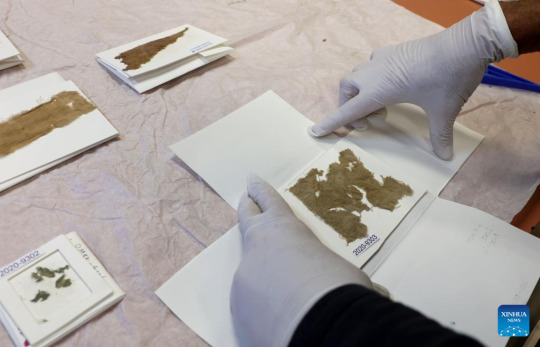

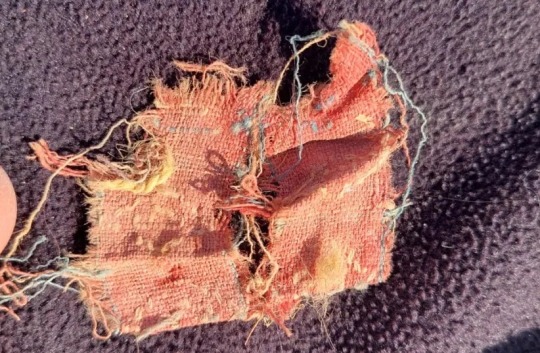
1,300-Year-Old Fabrics — Still Vividly Colored — Unearthed in Israel
Filled with food waste, junk mail and wrappers, our trash speaks volumes about how we live day-to-day. While the items people discard have changed over the centuries, the revealing nature of human trash has not.
That’s why a team of archaeologists hoping to understand the lives of ancient traders decided to find, excavate and analyze trash deposits along Silk Road routes in Israel. Digging into the desert ground at Aravah, the researchers uncovered a “treasure trove” of trash, according to a Jan. 17 news release from the Israel Antiquities Authority.
The “trash mounds” contained cotton and silk fabrics likely imported from China and India about 1,300 years ago, researchers said. Based on the location, features and age of the fabrics, archaeologists concluded the Aravah site was along a branch of the Silk Road’s network of trade routes.
The Silk Road refers to a network of trade routes stretching from China across the Middle East and into North Africa and Europe, according to National Geographic. Goods, such as silk, spices, tea and porcelain, were traded along the network from around 130 B.C. until 1453 A.D. The trade network also facilitated the spread of ideas, cultures and religions.
The “garbage” in Aravah included silks from China, decorated fabrics from India and cotton textiles from India and Nubia, a region in Sudan, the release said. These fabrics are still vividly colored, photos show.
One fabric fragment had a section of red, blue and gold stripes running through the center. Archaeologists attributed some of the weaving techniques to Iran and some of the designs to central India.
Another faded blue fabric boasted a gold design with checkerboard stripes and spheres. The “variety and richness” of the fabrics indicated a high demand for imported luxury goods in the region, researchers noted.
Archaeologists also found leather, clothing and hygienic items buried in the trash heap. Photos show one fabric piece with thick red and blue stripes. The finds illuminated the material culture and day-to-day lives of the region’s ancient residents and traders.
Exploring the Israeli Silk Road is an ongoing project for Guy Bar-Oz, Roi Galili, Orit Shamir, Berit Hildebrandt and Nofar Shamir, according to the team’s project website. Their research aims to “better understand the movements of textile goods, traders, and consumers” by focusing on “often-neglected smaller settlements.”
Aravah, also known as Arabah or Araba, is a region about 145 miles southeast of Jerusalem and along the Israel-Jordan border.
By Aspen Pflughoeft.
#1300-Year-Old Fabrics — Still Vividly Colored — Unearthed in Israel#Aravah#silk road#cloths#ancient artifacts#archeology#archeolgst#history#history news#ancient history#ancient culture#ancient civilizations#ancient israel
19 notes
·
View notes
Text


plans for my butch and femme dragons, hadas and aravah! they will eat u >:)
#i already have hadas fully gened and everything i just need the skin#which im. not too optimistic about getting anytime soon or ever lmao#and aravah is just a scry she wont actually exist for ages.. her skin is also really expensive might just use a dif one#my gf met someone in a sukkah and they sent me hadas with the message 'hey i met you girl in a sukkah here's a dragon'#it was past 1am i had no idea what was going on surreal experience#also1!!! hadas is a trans girl <3#abberations r all lesbians or trans girls are both the energy is just so apparent#i fucking love them#flight rising
32 notes
·
View notes
Text







dump of art i’ve recently made xux

ft kitty dave haha
#aravah speaks#original art#original digital art#digital art#homestuck#tw eyestrain#cw eyestrain#wp art
1 note
·
View note
Note
Hi there! Hope you’re having a good day mama spider. Just dropping by to ask for some info on an addition to a post about Judaism you made. I chose to ask you and not op because i’ve sent you an ask before and know that you answer them. So real quick, why did you type out G-d rather than God or god? Does it have something to do with Judaism? Is it just for the faithful to follow and not goyim? As an atheist who was formerly Catholic i just wanna learn more and be respectful of others’ religions whenever i can. I know next to nothing about Judaism, even though they’re a good portion of my county’s population. Hope this ask isn’t insensitive in any way, and thanks for taking the time to read this <3
This isn't insensitive to ask. It's actually a great question, and I'm glad that you asked if you're curious.
Since those articles cover your asks pretty well, I'm gonna give you some free bits of info to help your quest for respectfulness, which is pretty rad, btw: we don't really use phrases like "the faithful" bc Judaism doesn't require faith in G-d. There is no conflict between Judaism and atheism & there are a lot of Jewish atheists and agnostics. Judaism is an ethnoreligion and a people in a way that a lot of religions aren't, and in fact, the symbolism for one of my favorite holidays emphasizes that we are not complete without all kinds of Jews:
The functions of the four species are defined by both their smell and taste, or lack thereof, along with some interesting imagery from the Midrash (Vayikra Rabbah 30:12):
The etrog has both taste and smell, representing people who both perform good deeds and have Torah (knowledge).
The lulav has taste but no smell, representing those who do not use their knowledge to perform good deeds.
The hadass (myrtle) has smell but no taste, representing those who perform good deeds but lack the knowledge to excel at them.
The aravah (willow) has no taste and no smell, representing those who lack both.
"Good deeds" here doesn't just mean "being nice to your neighbors" but refers directly to performing mitzvot/mitzvahs, the 613 commandments that observant Jews observe to varying levels of specificity and intensity.
It's not offensive to use a phrase like "the faithful," just isn't ... correct, you know? Instead, you'd just say Jews or Jewish people. If you're trying to refer specifically to Jews who are religious or believe in G-d... there isn't exactly a phrase for that, I guess you'd say "observant," because there are a lot of Jews who are observant but also atheists, since observant Jews may be observing mitzvaot for any number of reasons that have nothing to do with belief in the existence of G-d.
Anyway, there you go, with some bonus info. As always, I don't speak for everybody, 2 Jews 3 Opinions, etc.
520 notes
·
View notes
Text
🔅Wed morning - ISRAEL REALTIME - Connecting to Israel in Realtime
( Update 1 of 2 )
🔻AIR ATTACKS..
.. North - Hezbollah
ROCKETS at Gesher HaZiv, Nahariya, Sa'ar, Hanita, Ya'ara, Metzuba, Shlomi, Betzet, Lehman
ROCKETS at Margaliot
ROCKETS at Even Menachem, Zarit, Netua, Fassuta, Shomera, Shtula
ROCKETS at Alkosh, Matat, Netua, Fassuta, Hurfeish
Interceptions without alarm reported over the Kinerret
.. South East - Iranian Shia Militias of Iraq
SUICIDE DRONE at Kushi Rimon
.. South West - Hamas
ROCKETS at Kissufim
▪️TERROR - KOCHAV YAIR.. ramming attack - 4 policemen were injured and the terrorist was shot dead.
▪️VIOLENT ANTI-GOVT PROTESTS JERUSALEM.. MK Zeev Elkin: Hard pictures in Jerusalem. There is no place for breaking the law and harming the police! There is no place for police violence and excessive use of force! Please stop! We are not enemies to each other. Hamas, Hezbollah, Iran are the enemies! We are in the middle of a war against a murderous enemy who wants to destroy all of us, the supporters of the government and its opponents.
Head of Shin Bet.. “The violent discourse on the Internet and some of the scenes we saw tonight in Jerusalem, go beyond the accepted rules of protest, harm the ability to maintain public order, may lead to violent friction with the security forces, hinder them from fulfilling their duties and even harm secure individuals.
There is a clear line between a legitimate protest and a violent and illegal protest. This is a worrisome trend that may lead to dangerous areas that should not be reached."
And our enemy watches Al Jazeera and laughs.
▪️IDEAS.. Head of Yisrael Beitenu, former Minister of Defense, MK Avigdor Lieberman:
"The Israeli government must make two immediate decisions:
1. In the security field, there is no justification for purchasing aircraft for a total amount of approximately NIS 35 billion. It is impossible for militias in sandals to be able to launch cruise missiles and UAVs (suicide drones) towards Israel, while in order to attack in Yemen, the Israel needs to put an entire squadron into the air for a flight thousands of kilometers south.
Therefore, instead of purchasing airplanes for approximately 35 billion shekels, you can purchase airplanes for approximately 20 billion shekels, and invest 10 billion shekels in establishing an effective missile force that will meet the security challenges, and five billion shekels to strengthen the land army.
2. In the economic field, we must immediately bring to Israel about a quarter of a million foreign workers, who are needed in the construction, industry, agriculture and hotel industries.
After almost half a year of war, it's time to change mindsets.”
( Update 2 of 2 )
🔻AIR ATTACKS..
.. North - Hezbollah
ROCKETS at Alkosh, Matat, Netua, Fassuta, Hurfeish
▪️CEASEFIRE LEAKS.. The Lebanese Al Mayadeen from a "senior source in the resistance": The new proposal submitted by Israel today does not provide an answer to the main issues that Hamas insists on and therefore there is no progress in the talks.
Al-Arabiya: Israel showed some flexibility proposing establishing 3 safe crossings to the north of the strip, but demanded health checks on the hostages in return.
▪️MORE INFO ON ARAVAH DRONE ATTACK.. At around 1 a.m., a suspected drone flying from the eastern direction entered Israeli airspace in the Arabah region, just north of Eilat, according to the IDF.
The "suspicious aerial target" set off sirens at a popular roadside store in the area.
The IDF says it fired an interceptor missile at the target, although it is not clear if it was shot down. (Fabien)
▪️MORE INFO ON THE RAMMING ATTACK.. a 26-year-old man from the Arab city of Tira rammed his vehicle into four cops near the town of Kochav Yair, police say. One of the officers was seriously wounded.
The assailant then fled to a nearby West Bank checkpoint, where he allegedly tried to stab the guards there. The guards at the Eliyahu Crossing returned fire, killing the suspect.
His family: our son has mental disorders. It was not on a nationalistic basis.
▪️IRANIAN SHIA MILITIA SAYS ATTACKED HAIFA? The Shia militias in Iraq claim: We attacked the airport in Haifa early in the morning with a UAV. No such attack.
▪️PASSOVER ECONOMY.. Min. Of Economy found a 32% gap between expensive and discount grocery chains on the ‘average basket of Passover foods’. It also noted an overall 4% increase from last year.
32 notes
·
View notes
Text
Happy Sukkot
It's my favorite Jewish holiday! (well tonight it will be!) Sukkot! For any Goyim, non-Jews reading this most likely you've never ever heard of this Jewish holiday because it's not close to Christmas or one of the big 3 Jewish holiday so let me explain.
Sukkot also called Tabernacles (maybe that rings a bell for the Christians) is a Jewish harvest festival set in a time of year when Israelites would have brought in the harvest.
to celebrate for a week (this year it's sundown October 9th through sun down October 17th, if you're outside of Israel, which I am) you eat outside.
okay it's a little more complex, you build a hut, a booth called a sukkah (sukkot is the plural) traditionally it should be made of palm fronds etc but around the world people kinda make do, but the roof should be made of plant matter, the walls and floor less of a problem.
here are some examples
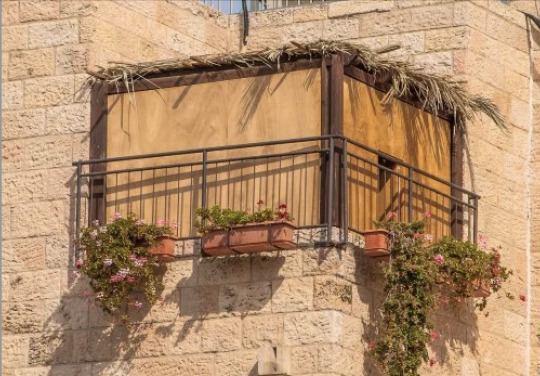
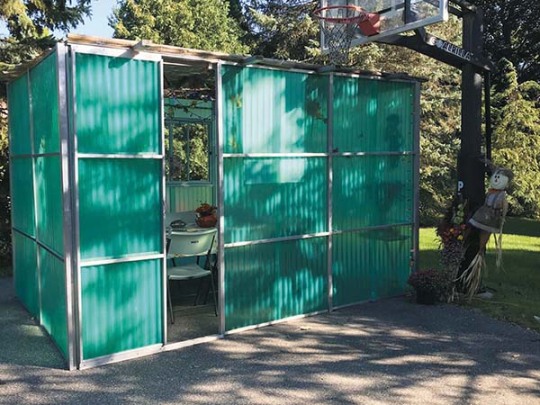

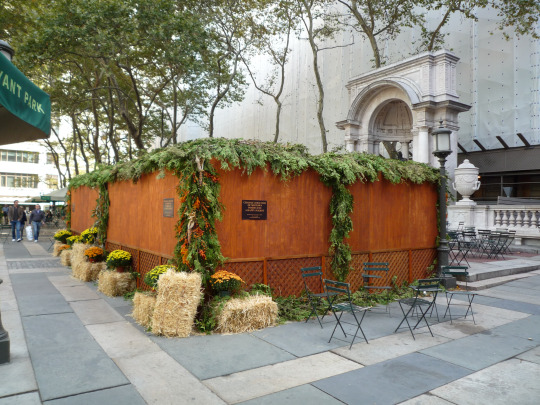
If you live in an area with a large Jewish community you may have noticed the symbol of the holiday, you may have seen Jewish gentlemen walking by with what look like very large lemons, they aren't lemons
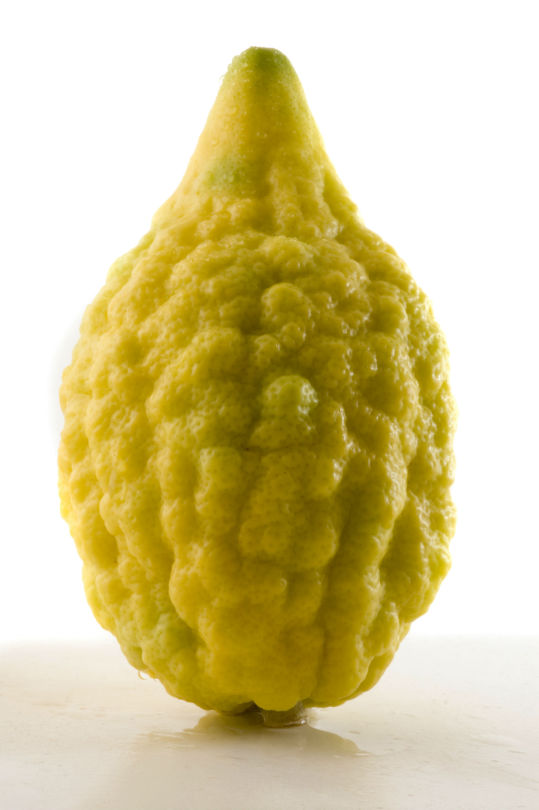
It's an Etrog, it is a citrus fruit, but its not a lemon. Together with the branch of a willow, myrtle, and a frond of a palm (called, Aravah, Hadass, and Lulav respectively) Jews during Sukkot wave them about their sukkah


so Chag Sameach! (happy holiday) and enjoy these Rabbis looking at Etrog





235 notes
·
View notes
Text

The loo-'lav לולב 💚
It is more than just a palm frond; it's a deeply symbolic component of the Jewish festival of Sukkot.
Traditionally, the loo-'lav is bundled with two other types of branches we will focus on next —myrtle (hadas) and willow (aravah)—and held together with the etrog we covered yesterday. This quartet is known as the "Four Species" ארבעת המינים.
Each of the four species symbolizes a different type of individual, and their unification stands for the idea of Jewish unity.
The loo-'lav, with its taste but no smell, represents those who are knowledgeable in the Torah but don't perform good deeds, highlighting the importance of balancing both.
It's like a lesson in botanical form: unity in diversity, a life enriched by varying strengths and talents.
Using the loo-'lav is an immersive experience. You'll shake it in all six directions—north, south, east, west, up, and down—to acknowledge that God is everywhere.
As you grip the lulav and etrog and perform the ritual shaking, it's a tactile reminder of the blend of agricultural and spiritual themes in Sukkot, linking not only to our roots but also to the divine.
So when you hold the loo-'lav this Sukkot, know that you're part of an ancient tradition, rich in symbolism and cultural depth. It's not just a set of plants; it's a bouquet of teachings, a lush green link to history, culture, and spirituality.
Happy Sukkot!
#palm fronds#hebrew#jewish#learnhebrew#hebrewbyinbal#language#hebrew langblr#israel#jew#torah#trending#sukkot#languages#hebrew language#language learning
26 notes
·
View notes
Text
Listen to me, you pursuers of justice,
you who seek Adonai:
consider the rock from which you were cut,
the quarry from which you were dug —
consider Avraham your father
and Sarah, who gave birth to you;
in that I called him when he was only one person,
then blessed him and made him many.
For Adonai will comfort Tziyon,
will comfort all her ruined places,
will make her desert like ‘Eden,
her ‘Aravah like the garden of Adonai.
Joy and gladness will be there,
thanksgiving and the sound of music.
Isaiah 51:1-3
#God/Adonai#Jesus Christ/Yeshua HaMaschiach#Holy Spirit/Ruach HaKodesh#Bible verses#Christian living
3 notes
·
View notes
Text
How Nature is Interpreted Through Jewish Culture
Hey everyone, for this week’s topic, since I’m Jewish, I decided I would talk about how Judaism relates to nature and interprets the environment.
There is an important concept in Judaism called bal tashchit (Hebrew: בל תשחית). This is the idea not to destroy or waste unnecessarily and refers anything natural or manmade that may still be useful in some capacity (Neril, 2024). This comes with a strong sentiment to only use natural resources as necessary, and make sure not to overexploit them (Neril, 2024). It also further applies to wasting food such as leftovers that get left in the fridge, or extra food left on a plate after getting full (Neril, 2024). The idea is that nothing should be wasted, and we should make sure to be mindful of how and why we use things, especially natural resources around us.
Environmental considerations can also be seen in many Jewish holidays and practices. The most obvious example of this is the holiday Tu Bishvat (Hebrew: ט״ו בִּשְׁבָט). Tu Bishvat is the name of a date in the Hebrew calendar which is considered the first day of spring in the land of Israel. The entire holiday is based around celebrating the plants native to Israel, and people normally celebrate by making sure to eat Israeli fruits and talking about the trees or plants of the region. This breeds a sense of appreciation for what we get from nature and celebrates the start of spring and the return of greenery. There is actually a common practice in Israel that every seven years all farming is stopped for a full year to give the land time to rest and recuperate from the strains of farming (My Jewish Learning, 2024). It is believed that environmental issues are actually symptomatic of moral degradation, and that we have an obligation to take care of the land around us (My Jewish Learning, 2024). Another holiday that celebrates nature is Sukkot (Hebrew: סכות). Part of this holiday involves taking four species native to Israel: lulav (palm frond; Hebrew: לולב), etrog (citron; Hebrew: אתרוג), hadass (myrtle; Hebrew: הדס), and aravah (willow; Hebrew: ערבה) and incorporating them as part of prayers during the holiday. These specific species are used to display and appreciate the natural beauty of the plants Jewish culture developed around. Jewish practices have many aspects emphasizing nature, and appreciation for the environment is vital to Jewish culture.
One way that Jewish environmentalism is currently expressed is through kibbutzim (Hebrew: קיבוצים). A kibbutz is a type of secular Jewish commune established in Israel that is traditionally based on agriculture. People living in kibbutzim tend to be very environmentally oriented, both because of their agricultural livelihood and because the people who choose to live in them are very left-leaning politically (they are choosing to live in a socialist or communist commune) which tends to accompany environmentalism. I stayed on a kibbutz with my partner’s family for a few days during a trip to Israel, and I had the chance to experience the way they interact with nature first-hand. The kibbutz itself was very green and covered in fruit trees and edible plants despite being in the middle of a desert. The people there also seemed to really appreciate interacting with nature. I was given a tour of the kibbutz, where at almost every spot they mentioned some aspect of the nature there with a ton of excitement. I also noticed that the family I was staying with did not even have a garbage can, since their only waste was either compostable or occasionally recycling, which they had a little blue bin for. Most of the food they ate was either grown there or bought from a local farm. They made sure to show me (very proudly) where they grew their fruits and veggies, where they kept their cows, and how they made their own bread. They also had me come out a choose what herbs I liked from their garden to make tea. There was an abundance of solar panels, and everyone seemed to walk or bike everywhere within the community. Every aspect of life there was extremely focused on being environmentally sustainable and with great appreciation for nature. After staying there for just a few days, I found myself significantly more appreciative of how feasible and enjoyable living sustainably feels. Overall, Jewish culture has a significant emphasis on appreciation for nature and this is generally expressed through environmental practices and celebrations of the nature in the land of Israel.

A famous waterfall I visited (Ein Gedi) in Israel near the kibbutz I stayed in.
Works Cited
Y. Neril (Feb. 6, 2024). Judaism and environmentalism: bal tashchit. Chabad.org https://www.chabad.org/library/article_cdo/aid/1892179/jewish/Judaism-and-Environmentalism-Bal-Tashchit.htm
My Jewish Learning (Feb. 6, 2024). Jewish teachings on nature and the environment. https://www.myjewishlearning.com/article/traditional-jewish-teachings-on-nature-and-the-environment/
My Jewish Learning (Feb. 6, 2024). Jewish views on nature and the environment. https://www.myjewishlearning.com/article/nature-the-environment-101/
0 notes
Text
https://x.com/hilzfuld/status/1711300093263991059?s=46&t=bW9HwLLTLOWBYfpaM2GzdA
He Who blessed our forefathers Abraham, Isaac and Jacob - may He bless the fighters of the Israel Defense Force, who stand guard over our land and the cities of our God from the border of the Lebanon to the desert of Egypt, and from the Great Sea unto the approach of the Aravah, on the land, in the air, and on the sea.
May Hashem cause the enemies who rise up against us to be struck down before them. May the Holy One, Blessed is He, preserve and rescue our fighting men from every trouble and distress and from every plague and illness, and may He send blessing and success in their every endeavor.
May He lead our enemies under their sway and may He grant them salvation and crown them with victory. And may there be fulfilled for them the verse: For it is Hashem, your God, Who goes with you to battle your enemies for you to save you.
Now let us respond: Amen.
0 notes
Text

The "Four Kinds"
"And you shall take for yourself on the first day," instructs the Torah in Leviticus "the splendid fruit of a tree, fronds of dates, the branch of the thick-leafed tree and aravot of the river." Torah SheBaal Peh (the oral tradition given to Moses at Sinai and handed through the generations, and later documented in the Mishnah and Talmud) identifies the four kinds as the etrog (citron), lulav (unopened palm branch), hadass (myrtle twig, of which three are taken) and aravah (willow, two twigs). The palm branch, three myrtle twigs and two willow twigs are bound together (with rings made from palm leaves).
Each day of Sukkot -- except Shabbat -- we take the lulav in hand, recite a blessing over it, take hold of the etrog, hold the "Four Kinds" together, and move them back and forth in all directions (right, left, forward, up, down and back). An additional blessing, shehecheyanu, is recited the first time that the Four Kinds are taken during the festival. We also hold the Four Kinds during the Hallel prayer (moving them as above in specified places in the text) and the Hoshaanot prayers (during which we march around the reading table in the synagogue) which are included in the daily service each day of Sukkot.
1 To God be the glory, great things he has done!
So loved he the world that he gave us his Son,
who yielded his life an atonement for sin,
and opened the life-gate that all may go in.
Refrain:
Praise the Lord! Praise the Lord,
Let the earth hear his voice!
Praise the Lord! Praise the Lord!
Let the people rejoice!
O come to the Father through Jesus the Son
and give him the glory, great things he has done!
2 Great things he has taught us, great things he has done,
and great our rejoicing through Jesus the Son,
but purer and higher and greater will be
our joy and our wonder, when Jesus we see
Adamow Alexis
Title:'After the Rain'
1 note
·
View note
Text
MAJOR SPOILER TO MY STORY: The AlteRealmS ORIGINS
Kinda wanted to make a horror art for Halloween, but I ultimately failed, as I am not skilled enough to do horror arts yet.
Anyway, say hello to Aravah. He will sound and look familiar to 2 certain someone’s…. (Inspired by 2 fandoms, character design and concept of the human by me and his backstory is also half by me)) (tags will reveal away, if you want them)
Happy Halloween :D

1 note
·
View note
Text
Quiz: Which of the Arba Minim Are You?
The Jewish holiday of Succot starts this Friday night! One of the important rituals we do on this holiday is we take four specific plants and we put them in and we put them out and we put them in and we shake them all about!
These plants are collectively known as the Arba Minim (often translated to English as the Four Species) and you are in luck because I HAVE MADE A QUIZ TO FIND OUT WHICH ONE YOU ARE
tag your plant or leave it in a comment!!
#judaism#jumblr#am i jewish tumblr#Quiz#arba minim#four species#succot#lulav and etrog#lulav#etrog#hadas#aravah
12 notes
·
View notes
Text

Prayer for Members of the Israel Defense Force
He Who blessed our forefathers Abraham, Isaac and Jacob - may He bless the fighters of the Israel Defense Force, who stand guard over our land and the cities of our G-d from the border of the Lebanon to the desert of Egypt, and from the Great Sea unto the approach of the Aravah, on the land, in the air, and on the sea.
May Hashem cause the enemies who rise up against us to be struck down before them. May the Holy One, Blessed is He, preserve and rescue our fighting men from every trouble and distress and from every plague and illness, and may He send blessing and success in their every endeavor.
May G-d lead our enemies under their sway and may G-d grant them salvation and crown them with victory. And may there be fulfilled for them the verse: For it is Hashem, your G-d, Who goes with you to battle your enemies for you to save you.
Now let us respond: Amen.
Rabbi Yisroel Bernath
82 notes
·
View notes
Photo

In this photo, the “Four Species” of plants utilized on Sukkot: an Etrog, Lulav, Hadass, and Aravah. x
The four species are the four different plants which form an obligatory part of the rite of Sukkot according to the biblical commandment "And ye shall take you on the first day [of Sukkot] the fruit of goodly trees, branches of palm trees, and boughs of thick trees, and willows of the brook, and ye shall rejoice before the Lord your God seven days" (Lev. 23:40). "Ye shall dwell in booths for seven days" (Lev. 23:42) is also enjoined.
Sukkot goes until October 11th this year. To learn more about this important holiday, please click here!
126 notes
·
View notes